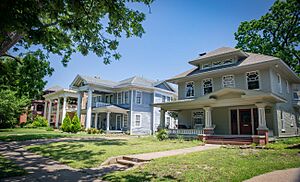Munger Place Historic District facts for kids
Quick facts for kids
Munger Place Historic District
|
|
|---|---|

Munger Place in 2022
|
|
| Country | United States |
| State | Texas |
| Counties | Dallas |
| City | Dallas |
| Area | East Dallas |
| Community | Old East Dallas |
| Area | |
| • Total | 85 acre (34 ha) |
| Elevation | 492 ft (150 m) |
| ZIP code |
75206, 75214
|
| Area code(s) | 214, 469, 972 |
|
Munger Place Historic District
|
|
| Architect | Multiple |
| Architectural style | Classical Revival, Prairie School, Bungaloid |
| NRHP reference No. | 78002916 |
| Significant dates | |
| Added to NRHP | September 13, 1978 |
The Munger Place Historic District is a special neighborhood in Old East Dallas, Texas in the USA. It's known for its beautiful old homes and rich history. This area is officially recognized as a Dallas Landmark District and is also listed on the National Register of Historic Places. This means it's an important place to protect because of its historical value. The district is generally located between North Fitzhugh Avenue, Gaston Avenue, Henderson Avenue, and Columbia Avenue.
Contents
Discovering Munger Place History
Munger Place was created in 1905 by a man named Robert S. Munger. He made cotton gins and planned this area to be one of Dallas's very first suburbs. It was meant to be a fancy and exclusive community.
Early Planning and Design
Munger Place was carefully designed to attract important people. It was only a short carriage ride from downtown Dallas. This neighborhood was the first in Texas to have "deed restrictions." This meant there were rules about how homes had to be built.
For example, houses had to be two stories tall. They also had to cost at least US$2,000, which was a lot of money back then. No house could face a side street. The area also had modern features like sidewalks, paved streets, shade trees, and electric street lights. Many of Dallas's leading business people and important families soon moved into these grand homes.
Changes Over Time
During the Great Depression, many large homes in Munger Place were divided into smaller apartments. This meant more families could live in them. The neighborhood lost some of its fancy reputation during this time. By the 1960s, some of the beautiful houses were even torn down or in bad condition.
However, in the 1970s, people started to rediscover Munger Place. They saw the amazing historic architecture, especially the Prairie Style homes. They realized these large houses had great potential, even if they looked a bit run-down.
Protecting Munger Place Heritage
Not all of the original Munger Place area is part of the Munger Place Historic District. The northern and western parts are in the Swiss Avenue Historic District. The southern part is generally in the Munger Place Historic District. Gaston Avenue separates these two historic districts.
Official Recognitions
In 1978, the National Park Service added the Munger Place Historic District to the National Register of Historic Places. This is a list of places across the country that are important to history. Then, in 1980, the City of Dallas also recognized it as a Landmark District. The boundaries for both of these special designations are almost the same.
A Special Collection of Homes
The Munger Place Historic District has over 250 homes. It is the largest collection of Prairie Style homes in America. Many of these homes have been fully restored. This has made Munger Place a popular neighborhood again for families. They love the charming, historic houses that are close to downtown Dallas. Each year, the neighborhood hosts a home tour and an art festival. These events attract people who enjoy historic architecture and local artists.
Education Opportunities
The Dallas Independent School District (DISD) serves the students in Munger Place.
Children living northeast of N Fitzhugh Avenue go to William Lipscomb Elementary School. This school is for grades PK-5. They then attend J.L. Long Middle School and Woodrow Wilson High School. Students living southwest of N Fitzhugh Avenue attend Ignacio Zaragoza Elementary School. After that, they go to Alex W. Spence Middle School and North Dallas High School.
Many children from the area also attend special magnet schools within the district. There are also several private schools nearby. These include Holy Trinity Catholic School, St. Thomas Aquinas Catholic School, Lakehill Preparatory School, St. John's Episcopal School, and First Baptist Academy.
Photo gallery








